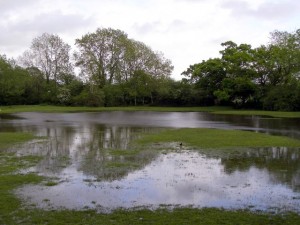Whether you’re facing heavy fall rains, spring snow melts, or were unfortunate enough to get caught in the recent hurricane, it takes special care to make sure your lawn will recover from flooding. With a little work ahead of time and some careful management, you can limit the damage and the cost of restoration.
Addressing Issues that can Make Flooding Worse
Making a few improvements to your lawn now can make a major difference when you’re faced with a major rainfall:
Clay soils don’t readily absorb water, letting it pool on the surface. Mulching grass or adding a thin layer of top soil can add an absorptive layer that can help drain away water.
Compacted soil also won’t absorb water. This can be a major problem around new construction where heavy equipment has been rolling over the ground, but heavy foot traffic can also cause compaction. Aerating can relieve compaction while adding a walkway can help redirect foot traffic away from the turf.
Your lawn’s root system can grow into thatch if it’s thick enough, increasing the damage done by flooding, and wet thatch can support the growth of molds and pests, lengthening recovery time. If the thatch layer is over a half inch thick, it needs to be removed.
In some areas, the water table may be so high that it can be pushed up to the point that the ground becomes saturated. If this is a problem, consider installing a French drain. This device uses a gravel-filled trench with a perforated pipe to drain off ground water.
Pooling water will do more damage than running water, so it’s important to install drainage in areas where the water can collect, including depressions and slopes. On relatively flat lawns, top soil can be added to fill in depressions, which will both help reduce stagnant water and provide an even surface that will be easier to take care of.
After the Flooding, Let the Lawn Dry Out
It may be tempting to start work right away, but any weight on water-saturated soil can damage the grass blades and lead to compaction that can damage the root structure. Depending on the severity of the flooding, this could take as long as two or three weeks.
Assessing the Damage
Flooding can leave behind a layer of silt that can sit on the grass, choking it. Light layers are easy to deal with, but inches of silt may require complete removal and replacement of the turf. This isn’t just an issue of extra dirt: floods can wash away household chemicals and oils, depositing them on your lawn and poisoning the soil.
Removing Debris
All manner of things from branches to broken glass may end up washed up on your lawn; this debris needs to be removed before you can safely use your lawn care equipment.
Aerating and Silt Removal
If silt built-up is under one inch, core aerating will often be enough to take care of it, while deeper deposits will need to be raked or washed off. Thick deposits will need to be removed with a sod cutter or turned using a tiller to disperse contaminants before replanting the grass.
Fertilizing
Water can wash away nutrients that your grass needs to thrive, particularly nitrogen and calcium. This usually shows up as yellowed grass as nitrogen is needed to make green chlorophyll. A fertilizer can be used to add back these nutrients, or ammonium nitrate can add nitrogen and gypsum can add calcium. These chemicals are less likely to wash out if there are future rains.
Keep Your Equipment Ready for the Fight Against Floods
Flood recovery can be daunting, but Billy Goat’s power rakes, aerators, sod cutters and overseeders can make the process easier. When you need parts for your Billy Goat equipment, visit Billygoatparts.com. We’re an OEM dealer for Billy Goat and their manufacturing partners so we can supply you with everything you need from new tines to engine components. Finding the right part is easy thanks to our search engine which lets you narrow options down by model and serial number and shows you factory parts diagrams and descriptions so you can identify exactly what you need. We ship parts and accessories across the U.S. and Canada.

